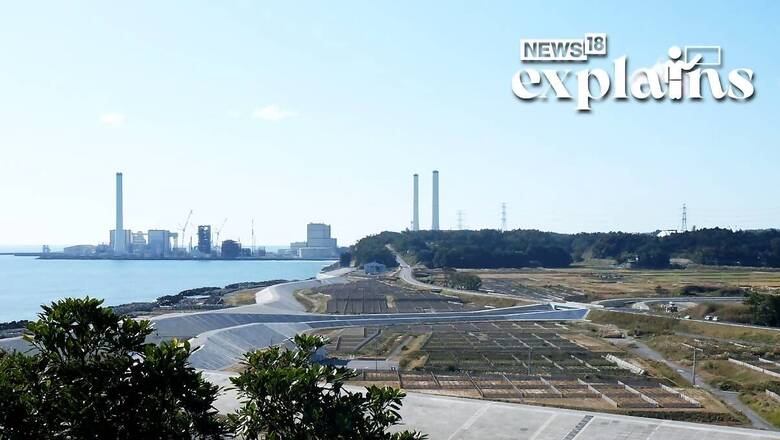
views
Japan has received approval from the United Nations’ nuclear watchdog to release treated radioactive water into the ocean, marking a significant step in a controversial plan that follows the Fukushima nuclear meltdown 12 years ago.
The decision comes after years of planning, during which the environment minister stated that there were no viable alternatives due to limited space for containing the contaminated material, as per a report by CNN.
Rafael Grossi, the head of the International Atomic Energy Agency (IAEA), arrived in Japan to visit Fukushima and deliver the UN body’s safety review to Prime Minister Fumio Kishida. However, despite the UN’s approval, residents in neighboring countries and local fishermen who still feel the effects of the 2011 disaster remain unsettled.
Some skeptics have raised doubts about the IAEA’s findings, and China has recently questioned the legality and legitimacy of the wastewater release, emphasizing that the IAEA’s assessment does not serve as proof.
About the Fukushima Meltdown
Twelve years ago, Japan experienced a catastrophic earthquake followed by a massive tsunami that caused extensive damage and led to the Fukushima nuclear disaster. The 9.0-magnitude earthquake, the strongest ever recorded in Japan, struck off the eastern coast, resulting in the displacement of the Earth’s axis. The ensuing tsunami devastated the main island of Honshu, claiming the lives of over 18,000 people and obliterating entire towns.
At the Fukushima nuclear power plant, the tsunami breached the defenses, causing flooding and a major nuclear crisis. To prevent a complete meltdown, the reactors automatically shut down, and emergency diesel generators kicked in to maintain coolant circulation. However, the tsunami wave, measuring over 14 meters (46 feet) high, overwhelmed the plant’s seawall, disabling the emergency generators. Workers made frantic efforts to restore power, but the cores of three reactors experienced partial meltdowns due to overheating.
Chemical explosions further damaged the plant’s structures, leading to the release of radioactive material into the atmosphere and the Pacific Ocean. As a result, authorities implemented an evacuation zone that expanded progressively, resulting in the displacement of over 150,000 people. While there were no immediate deaths directly caused by the nuclear disaster, 16 workers suffered injuries from the explosions, and numerous others were exposed to radiation while attempting to cool the reactors and stabilize the situation.
The long-term health effects of radiation exposure remain a subject of debate. In 2013, the World Health Organization (WHO) released a report stating that the Fukushima disaster would not significantly increase cancer rates in the affected region. Experts, both within and outside Japan, generally agree that beyond the immediate vicinity of the plant, the risks of radiation exposure remain relatively low, according to a report by BBC.
But despite official reassurances, many still perceive greater risks regarding the Fukushima disaster. As a result, residents remain cautious, and despite the lifting of restrictions in several areas, most people have chosen not to return to their homes.
In 2018, the Japanese government acknowledged that one worker had died as a result of radiation exposure and agreed to compensate the worker’s family. Apart from this, several people have been confirmed to have died during the evacuation process. This includes dozens of hospital patients who had to be relocated due to concerns about radiation.
How Will Japan Release the Water?
The process will take decades to complete, as per a Reuters report. The water was distilled after being contaminated from contact with fuel rods at the reactor, destroyed in a 2011 earthquake. Tanks on the site now hold about 1.3 million tonnes of radioactive water – enough to fill 500 Olympic-sized swimming pools. Here is how Tokyo Electric Power Company (Tepco) plans to deal with the water:
Tepco has been filtering the contaminated water to remove isotopes, leaving only tritium, a radioactive isotope of hydrogen that is hard to separate from water. Tepco will dilute the water until tritium levels fall below regulatory limits before pumping it into the ocean from the coastal site.
Water containing tritium is routinely released from nuclear plants around the world, and regulatory authorities support dealing with the Fukushima water in this way. Tritium is considered to be relatively harmless because it does not emit enough energy to penetrate human skin. But when ingested it can raise cancer risks, a Scientific American article said in 2014.
The water disposal will take decades to complete, with a rolling filtering and dilution process, alongside the planned decommissioning of the plant.
Tepco has been engaging with fishing communities and other stakeholders and is promoting agriculture, fishery and forest products in stores and restaurants to reduce any reputational harm to produce from the area. Fishing unions in Fukushima have urged the government for years not to release the water, arguing it would undo work to restore the damaged reputation of their fisheries.
Neighbouring countries have also expressed concern. China has been the most vocal, calling Japan’s plan irresponsible, unpopular and unilateral.
Is the Move Worrisome?
According to the Canadian Nuclear Safety Commission, tritium, a radioactive isotope of hydrogen, is not capable of penetrating the skin. However, consuming tritium in extremely large quantities can increase the risk of cancer. The US Nuclear Regulatory Commission acknowledges that any exposure to radiation carries some health risk but notes that everyone is exposed to small amounts of tritium on a daily basis, according to CNN.
Robert H. Richmond, the director of the Kewalo Marine Laboratory at the University of Hawaii at Manoa, is part of a group of international scientists collaborating with the Pacific Island Forum to evaluate the plan for releasing Fukushima’s wastewater. Their assessment involves visits to the Fukushima site and discussions with TEPCO, Japanese authorities, and the IAEA. After reviewing the details of the plan, Richmond described it as “ill-advised" and premature, as per CNN.
One concern raised by Richmond and others is that diluting the wastewater may not be sufficient to mitigate its impact on marine life. Substances like tritium can traverse various levels of the food chain, including plants, animals, and bacteria, and can accumulate within the marine ecosystem. This raises the risk of bioaccumulation, where these pollutants build up over time.
Richmond further emphasizes that the world’s oceans are already facing multiple stressors such as climate change, ocean acidification, overfishing, and pollution. Treating the ocean as a “dumping ground" would only exacerbate these challenges.
The potential risks associated with the wastewater release extend beyond the Asia-Pacific region. A study conducted in 2012 discovered evidence that bluefin tuna had transported radionuclides from Fukushima, including radioactive isotopes found in nuclear wastewater, across the Pacific Ocean to California.
Reuters contributed to this report



















Comments
0 comment